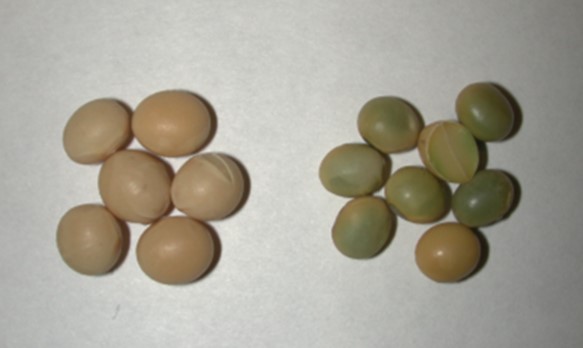Dry green soybean seeds at harvest are the result of an extremely dry growing season, especially during July and August and is more common on soils with poor water holding capacity. Green soybeans can occur even if the seed moisture has fallen below 13%. These green seeds are not the large unripe green beans that can be found when parts of a field that are not ripe are harvested along with mature seed. They are also not the result of an early frost, which results in seed being immature at harvest. Instead, a large percentage of mature dry green beans may be harvested along with normal yellow beans across the whole field. Under normal conditions, as the plant matures, an enzyme called chlorophyllase degrades the chlorophyll in the bean to result in a normal yellow seed colour. Under hot, dry conditions seed drying and maturation occurred so quickly that enzyme activity stops before all the chlorophyll can be metabolized within the seed, see figure 1. Depending on the percentage of green seed and other damage present in the sample, these beans are downgraded. The reason green soybeans are discounted by the crusher is that the chlorophyll has a direct impact on oil quality and content.

Figure 1. Mature dry green seed on the right compared to normal yellow seed on the left.
Types of Dry Mature Seed
There are two types of dry green soybean seed that can occur:
- Soybeans that have a green discolouration on the outside of the seed, while the inside remains yellow. This category of dry green soybeans is assigned Grade 2 and are not discounted.
- Soybeans that have a green discolouration throughout the entire soybean. This category of dry green soybeans is graded as damaged kernels and discounted. The bleaching required during processing increases processing costs and reduces oil yield.
Colour Improvement over Time
Since the beans are dry, the “activity” inside the seed is minimal. The enzyme (chlorophyllase) that normally breaks down the chlorophyll cannot function at such low moistures; therefore, the green colour will not disappear in storage. If there is only a green tinge on the outside of the bean, it may improve somewhat over time, especially if the crop is left in the field longer. If the seed is cut open and is green throughout it will not improve over time, either in storage or in the field. Green seed left in storage for 5 months showed very little improvement in one study of mature green seed conducted by OMAFA, see Table 1. Green Soybean Storage Study (% Green).
Table 1. Dry Green Soybean Storage Study (% Green)
| Sample | Initial | 2 Months | 5 Months |
| A 1 | 30.1 | 30.1 | 29.9 |
| A 2 | 31 | 31.2 | 31.4 |
| A 3 | 39.7 | 35.8 | 36.1 |
| A 4 | 34.2 | 35 | 33.1 |
| B 1 | 42.8 | 42.9 | 42.7 |
| B 2 | 38.9 | 39.3 | 39.8 |
| B 3 | 46.2 | 46 | 49.3 |
| B 4 | 38.2 | 39.2 | 39.9 |
| C 1 | 40.1 | 39.4 | 39.9 |
| C 2 | 33.2 | 31.9 | 31.5 |
| C 3 | 30.7 | 31.8 | 32.2 |
| C 4 | 30.4 | 30.6 | 30.2 |
| D 1 | 9.4 | 4.04 | 5.0 |
| D 2 | 7.6 | 5.2 | 5 |
| D 3 | 5.6 | 4.7 | 4.9 |
| D 4 | 3.9 | 3.9 | 3.8 |
| E 1 | 33.5 | 34.0 | 33.8 |
| E 2 | 39.9 | 36.3 | 39.2 |
| E 3 | 46 | 40 | 35.3 |
| E 4 | 40.9 | 39.6 | 38.6 |
| Average | 31.1 | 30.0 | 29.9 |
Germination and Vigour
Mature green seeds have lower germination and vigour. Three varieties were tested in an Ontario study, which showed that green seeds reduced germination by an average of 19%. Using the same three varieties, vigour was also tested using a stress test. The stress test involves seeds being placed into a growing medium at temperatures of 5ºC – 8ºC for seven days, followed by seven days at 25ºC. It was found that vigour dropped by an average of 38%. Vigour is a more reliable predictor of stand establishment when compared to germination.
How to Avoid Green Seed?
Little can be done to completely avoid having green seed since the weather cannot be controlled. Variety choice and planting date differences do exist, but these differences are not consistent. The best defense against mature green seed is a good crop rotation. along with planting an adapted variety for a given region.